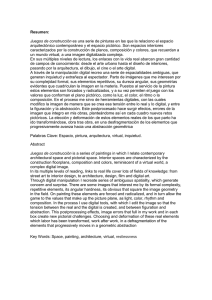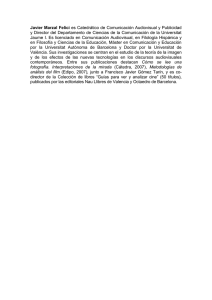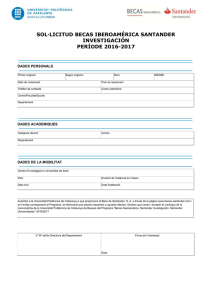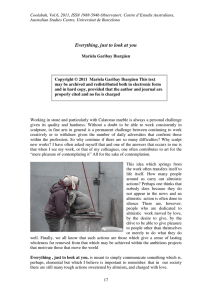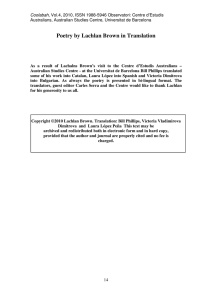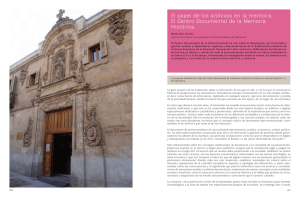Introduction Jaime de Córdoba Benedicto
Anuncio
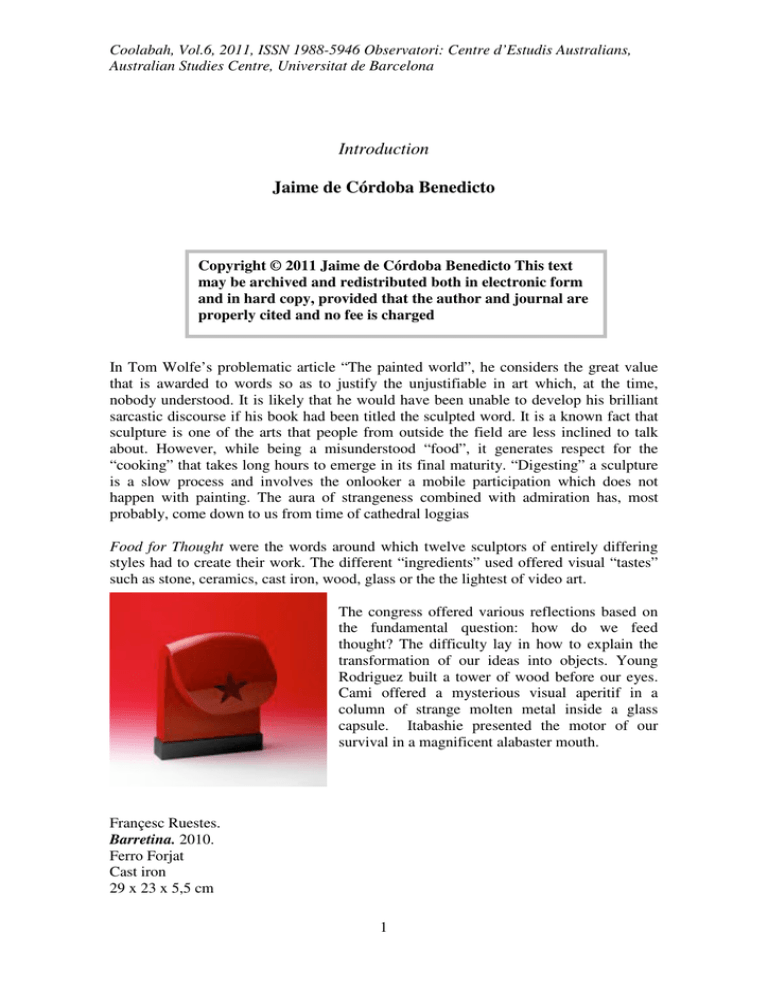
Coolabah, Vol.6, 2011, ISSN 1988-5946 Observatori: Centre d’Estudis Australians, Australian Studies Centre, Universitat de Barcelona Introduction Jaime de Córdoba Benedicto Copyright © 2011 Jaime de Córdoba Benedicto This text may be archived and redistributed both in electronic form and in hard copy, provided that the author and journal are properly cited and no fee is charged In Tom Wolfe’s problematic article “The painted world”, he considers the great value that is awarded to words so as to justify the unjustifiable in art which, at the time, nobody understood. It is likely that he would have been unable to develop his brilliant sarcastic discourse if his book had been titled the sculpted word. It is a known fact that sculpture is one of the arts that people from outside the field are less inclined to talk about. However, while being a misunderstood “food”, it generates respect for the “cooking” that takes long hours to emerge in its final maturity. “Digesting” a sculpture is a slow process and involves the onlooker a mobile participation which does not happen with painting. The aura of strangeness combined with admiration has, most probably, come down to us from time of cathedral loggias Food for Thought were the words around which twelve sculptors of entirely differing styles had to create their work. The different “ingredients” used offered visual “tastes” such as stone, ceramics, cast iron, wood, glass or the the lightest of video art. The congress offered various reflections based on the fundamental question: how do we feed thought? The difficulty lay in how to explain the transformation of our ideas into objects. Young Rodriguez built a tower of wood before our eyes. Cami offered a mysterious visual aperitif in a column of strange molten metal inside a glass capsule. Itabashie presented the motor of our survival in a magnificent alabaster mouth. Françesc Ruestes. Barretina. 2010. Ferro Forjat Cast iron 29 x 23 x 5,5 cm 1 Coolabah, Vol.6, 2011, ISSN 1988-5946 Observatori: Centre d’Estudis Australians, Australian Studies Centre, Universitat de Barcelona Metaphors, symbols and forms which demanded the congress delegates’ interpretation. No sculptor represented food itself. Some presented the body stuffed with paper as an image of thought within the human being. Ruestes represented the “nation in thought” with his barratina ( the traditional Catalan hat) accompanied by the only real food in the exhibition: a star shaped biscuit which fitted the cut out star in the hat. Lúa Coderch showed her slow video “Shelling a nut” in reference to Kafka, a resource also used by Luis Cera who covered his sculpture with innumerable words. These were ways of thinking or rather an exhibition on “ways of thinking” which attempted to materialize an international congress on how one should fight against intellectual starvation. We hope to continue to transform words into the material realm and, to pacify Wolfe, we hope that words will not flood the material. It is a great pleasure to be able to present this number of Coolabah in a bilingual edition. Jaime de Córdoba Benedicto. Escultor. Sculptor Universitat de Barcelona. Tom Wolfe en su polémico reportaje “The painted world” habría algunas consideraciones sobre el valor extremo que la palabra había adquirido para justificar lo injustificable en la pintura que entonces nadie entendía. Seguramente no hubiese podido desarrollar su brillante sarcasmo si su libro se hubiese titulado La palabra esculpida. De hecho la escultura es una de las artes sobre las que menos se atreven a hablar las” gentes de a pie”, las gentes de fuera del mundo artístico. Pero aún siendo un manjar incomprendido genera el respeto de la cocina que precisa muchas horas para su maduración. Su presencia física requiere una digestión paulatina y el entendimiento de una participación móvil del espectador que no surge en la pintura. Y probablemente conservó, desde las logias de las catedrales, un aura de extrañeza y a la vez admiración que ha perdurado hasta nuestros dias. Food for thought fueron las palabras a las que debíamos dar forma entre 12 escultores bien distintos. Se presentaron ingredientes tan diferentes en su sabor visual como la piedra, la cerámica, el hierro fundido, la madera el cristal o el más liviano video arte. El conjunto en el Congreso ofreció reflexiones sobre la gran pregunta de ¿Cómo alimentar nuestro pensamiento? L a dificultad estaba servida si entendemos que sólo la presencia de los objetos iba a explicar la transformación de nuestras ideas. El adolescente de Rodriguez hacia crecer ante nuestros ojos una torre de madera; en una columna Camí exponía un misterioso aperitivo visual en un extraño metal fundido encerrado en una cúpula de cristal, Itabashie nos presentaba el verdadero motor de nuestra supervivencia en una magnífica boca de alabastro. Françesc Ruestes. Barretina. 2010. 2 Coolabah, Vol.6, 2011, ISSN 1988-5946 Observatori: Centre d’Estudis Australians, Australian Studies Centre, Universitat de Barcelona Ferro Forjat 29 x 23 x 5,5 cm Metáforas, símbolos y formas que llamaban a la interpretación de los congresistas. No hubo ningún escultor que representase directamente la comida. Otros mostraron el cuerpo rellenado de papeles como imagen del pensamiento dentro del hombre, Ruestes expusó la idea de “nación pensada” en su barratina ( gorro tradicional catalán) acompañada del único alimento real: una galleta con la misma forma que faltaba en su escultura. Y Lúa Coderch nos mostraba su lentísimo video”cascar una nuez” en referencia a la literatura de Kafka , recurso que usó, igualmente Lluís Cera al grabar infinitas palabras en su piedra. Fueron formas para pensar o más bien una exposición de “Formas de pensar” que intentó materializar el esfuerzo de un Congreso Internacional sobre como debemos luchar contra la desnutrición intelectual. Esperamos seguir convirtiendo el verbo en materia y, tranquilizando a Wolfe, esperamos que el verbo no inunde en exceso a la materia. Jaime de Córdoba Benedicto. Escultor. Universitat de Barcelona. 3
